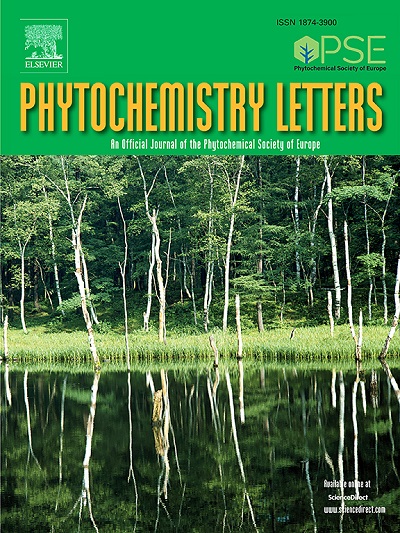用生物测定法分离红毛蕊萜类化合物
IF 1.4
4区 生物学
Q4 CHEMISTRY, MEDICINAL
引用次数: 0
摘要
蔷薇科蔷薇科植物蔷薇是一种辅助治疗癌症的传统中草药,其生物活性化学成分有待进一步挖掘。本研究以生物测定法为指导,从红毛蕊草全药煎液中分离得到7个倍半萜类(1 - 7)和8个三萜类(8 - 15),包括一个未描述的化合物(1)。通过详细的HR-ESI-MS,广泛的光谱分析和改进的Mosher酯法对它们的结构进行了阐明,并修改了(-)-hyptishumulene I(2)的绝对构型。在生物实验中,山茱萸酸(10)和山茱萸酸(11)对所有被测试的人类癌细胞系A549、MDA-MB-435和SNB19表现出中等的细胞毒性,IC50值在16.20 ~ 33.63 μM之间。此外,据报道,花椰菜酸和山茱萸酸能够抑制STAT3和NF-κB,或增加癌细胞的细胞膜通透性,诱导细胞凋亡,这表明它们是红叶蔓汤剂中重要的生物活性抗癌成分。本文章由计算机程序翻译,如有差异,请以英文原文为准。
Bioassay-guided isolation of terpenoids from Rubus rosifolius
Rubus rosifolius S.Vidal, a plant from the Rosaceae family, is a traditional Chinese herbal medicine utilized as an adjunctive therapy for cancer, and its bioactive chemical constituents need further unearthing. In this work, seven sesquiterpenoids (1 – 7) and eight triterpenoids (8 – 15), including an undescribed compound (1), are bioassay-guidedly isolated from the decoction of the whole herb of Rubus rosifolius. Their structures are elucidated via detailed HR-ESI-MS, extensive spectroscopic analyses, and modified Mosher ester method, and the absolute configuration of (-)-hyptishumulene I (2) was revised. In bioassay, corosolic acid (10) and maslinic acid (11) exhibit moderate cytotoxicity against all tested human cancer cell lines, A549, MDA-MB-435, and SNB19, with IC50 values in the range of 16.20 – 33.63 μM. Additionally, corosolic acid and maslinic acid have been reported to be capable of inhibiting STAT3 and NF-κB, or increasing membrane permeability of cancer cells and inducing apoptosis, which suggests they are the important bioactive anti-cancer components of the decoction of Rubus rosifolius.
求助全文
通过发布文献求助,成功后即可免费获取论文全文。
去求助
来源期刊

Phytochemistry Letters
生物-生化与分子生物学
CiteScore
3.00
自引率
11.80%
发文量
190
审稿时长
34 days
期刊介绍:
Phytochemistry Letters invites rapid communications on all aspects of natural product research including:
• Structural elucidation of natural products
• Analytical evaluation of herbal medicines
• Clinical efficacy, safety and pharmacovigilance of herbal medicines
• Natural product biosynthesis
• Natural product synthesis and chemical modification
• Natural product metabolism
• Chemical ecology
• Biotechnology
• Bioassay-guided isolation
• Pharmacognosy
• Pharmacology of natural products
• Metabolomics
• Ethnobotany and traditional usage
• Genetics of natural products
Manuscripts that detail the isolation of just one new compound are not substantial enough to be sent out of review and are out of scope. Furthermore, where pharmacology has been performed on one new compound to increase the amount of novel data, the pharmacology must be substantial and/or related to the medicinal use of the producing organism.
 求助内容:
求助内容: 应助结果提醒方式:
应助结果提醒方式:


